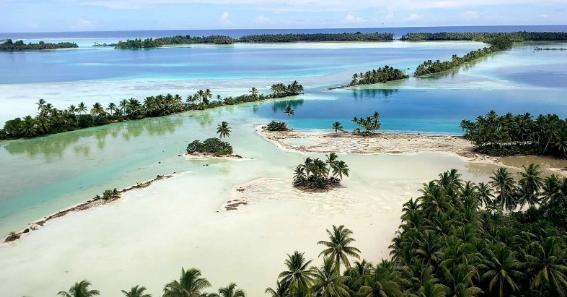As climate change continues to cause marine heatwaves, coral reefs face unprecedented threats. However, researchers have discovered a phenomenon that holds promise for coral reef managers in their efforts to mitigate these challenges and plan for the future.
The tropical Pacific experiences periodic climate shifts known as El Niño, characterized by notable alterations in winds, weather patterns, and ocean temperatures. One of the most formidable El Niño events on record occurred from April 2015 to May 2016, leaving a lasting impact on the Central Pacific region.
During the intense El Niño event in 2015-2016, coral reefs in the Central Pacific, including those in Palmyra, faced immense stress from elevated ocean temperatures, leading to widespread coral bleaching. However, a team of scientists from KAUST and around the world discovered that localized ocean processes played a crucial role in nourishing the coral reefs and enabling their remarkable resilience. These findings shed light on the diverse responses of coral reefs to environmental stress, enhancing our understanding of their adaptive capabilities.
In the face of climate change impacts, identifying naturally protected reefs holds significant promise for coral reef managers and conservationists. By pinpointing these resilient reef systems, efforts can be directed towards repopulating and restoring corals that are more vulnerable to the effects of climate change. This approach has the potential to bolster the long-term survival and resilience of coral ecosystems in the face of ongoing environmental challenges.
The unexpected positive outcomes of El Niño have astonished researchers, including coral reef ecologist Michael Fox from KAUST. While this climate phenomenon brought devastation to coral reefs on equatorial Central Pacific islands, it simultaneously created favorable conditions slightly further north. This revelation challenges previous assumptions and highlights the intriguing resilience and adaptability of corals even in the midst of significant El Niño events.
Fox’s reference pertains to the intriguing sequence of events that unfolded in 2015-16, enabling the survival of Palmyra’s reefs while those just 700km south on the equatorial islands of Kiritimati and Jarvis faced a different fate. Typically, during El Niño, the equatorial ocean current weakens, resulting in a decline of the essential nutrients that are typically upwelled to the surface when the current is robust.
However, in a more northern region, Fox and his team discovered a different scenario. They observed that the eastward-flowing North Equatorial Counter Current, which directly impacted Palmyra’s western shores, experienced a substantial strengthening during the 2015-16 El Niño event. As a result, a shallower sea surface layer formed around Palmyra, facilitating the upward movement of cooler waters abundant in plankton towards the coral reefs of the island. This process played a vital role in helping the reefs cope with the elevated heat stress caused by the rise in ocean surface temperatures.
According to Fox and his research team, ocean models indicate that the critical processes observed during the 2015-16 El Niño were also evident in the two other significant El Niño events that occurred in the last 50 years. This data suggests that these oceanic mechanisms played a vital role in the survival of Palmyra’s coral reefs during previous extreme marine heatwaves and could potentially offer a means of resilience for the future as well.
According to Fox, heatwaves associated with El Niño pose the most significant threat to coral reef ecosystems worldwide. These events have extensive consequences across tropical regions and can lead to widespread coral mortality. The identification of coral reefs with a higher likelihood of survival during these extreme events is crucial for gaining insights into the future of coral reef ecosystems.
The findings of the study raise an important question: Are there other locations where similar ocean conditions occur during El Niño, resulting in better-than-expected reef conditions?
“This study serves as a guide for exploring other reef areas that defy the global trend of decline,” says Fox. “This information will be valuable for decision-makers in Pacific islands who are considering the placement of marine protected areas or making future plans.”
“Palmyra Atoll provides an excellent opportunity to study the effects of climate change on coral reefs and, more importantly, to identify factors that contribute to reef resilience,” says Joseph Pollock, Senior Coral Reef Resilience Scientist of The Nature Conservancy’s Hawaii & Palmyra Programs.
“Due to its remote location and strict protection measures, the reefs of Palmyra Atoll have managed to preserve their ecological integrity, unlike many reefs worldwide that have suffered from local stressors like pollution and overfishing,” explains Pollock. “By comparing the responses of coral reefs in Palmyra to those in more degraded or disturbed areas, researchers can effectively isolate and understand the unique impacts of climate change.”
The Ecological Oceanography Lab at KAUST, led by Fox, intends to further explore this research in Palmyra and expand it to the Red Sea. This collaborative effort involves KAUST, Bangor University in the UK, Scripps Institution of Oceanography and the National Oceanic and Atmospheric Administration in the US, and The Nature Conservancy.
Fox’s group combines organismal physiology, community ecology, and oceanography to uncover the patterns and mechanisms that promote reef resilience in the face of climate change. Their research extends to the Red Sea, where they aim to understand how the physical processes operating in this extreme environment contribute to the persistence of these unique reefs.

